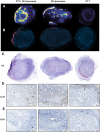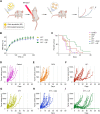Neoadjuvant Gold Nanoshell-Based Photothermal Therapy Combined with Liposomal Doxorubicin in a Mouse Model of Colorectal Cancer
- PMID: 36824412
- PMCID: PMC9942687
- DOI: 10.2147/IJN.S389260
Neoadjuvant Gold Nanoshell-Based Photothermal Therapy Combined with Liposomal Doxorubicin in a Mouse Model of Colorectal Cancer
Abstract
Introduction: Traditional cancer treatments, such as chemotherapy, are often incapable of achieving complete responses as standalone therapies. Hence, current treatment strategies typically rely on a combination of several approaches. Nanoparticle-based photothermal therapy (PTT) is a technique used to kill cancer cells through localized, severe hyperthermia that has shown promise as an add-on treatment to multiple cancer therapies. Here, we evaluated whether the combination of gold nanoshell (NS)-based PTT and liposomal doxorubicin could improve outcome in a mouse model of colorectal cancer.
Methods: First, NS-based PTT was performed on tumor-bearing mice. Radiolabeled liposomes were then injected at different timepoints to follow their accumulation in the tumor and determine the ideal injection time after PTT. In addition, fluorescent liposomes were used to observe the liposomal distribution in the tumor after PTT. Finally, we combined PTT and doxorubicin-loaded liposomes and studied the effect of the treatment strategy on the mice by following tumor growth and survival.
Results: PTT significantly improved liposomal accumulation in the tumor, but only when the liposomes were injected immediately after the therapy. The liposomes accumulated mostly in regions adjacent to the ablated areas. When PTT was combined with liposomal doxorubicin, the mice experienced a slowdown in tumor growth and an improvement in survival.
Conclusion: According to our preclinical study, NS-based PTT seems promising as an add-on treatment for liposomal chemotherapy and potentially other systemic therapies, and could be relevant for future application in a clinical setting.
Keywords: PET imaging; chemotherapy; gold nanoparticles; hyperthermia; liposomes.
© 2023 Simón et al.
Conflict of interest statement
The authors report no conflicts of interest in this work.
Figures




Similar articles
-
Nanoshell-mediated photothermal therapy can enhance chemotherapy in inflammatory breast cancer cells.Int J Nanomedicine. 2015 Nov 6;10:6931-41. doi: 10.2147/IJN.S93031. eCollection 2015. Int J Nanomedicine. 2015. PMID: 26609231 Free PMC article.
-
Fractionated photothermal therapy in a murine tumor model: comparison with single dose.Int J Nanomedicine. 2019 Jul 18;14:5369-5379. doi: 10.2147/IJN.S205409. eCollection 2019. Int J Nanomedicine. 2019. PMID: 31409993 Free PMC article.
-
The synergistic effect of chemo-photothermal therapies in SN-38-loaded gold-nanoshell-based colorectal cancer treatment.Nanomedicine (Lond). 2022 Jan;17(1):23-40. doi: 10.2217/nnm-2021-0187. Epub 2021 Dec 17. Nanomedicine (Lond). 2022. PMID: 34918941
-
[Hyperthermia on colorectal cancer: gold nanoshells-mediated photothermal therapy].Rev Med Inst Mex Seguro Soc. 2024 Jul 1;62(4):1-8. doi: 10.5281/zenodo.11397181. Rev Med Inst Mex Seguro Soc. 2024. PMID: 39542542 Review. Spanish.
-
Engineered Gold Nanoshells Killing Tumor Cells: New Perspectives.Curr Pharm Des. 2019;25(13):1477-1489. doi: 10.2174/1381612825666190618155127. Curr Pharm Des. 2019. PMID: 31258061 Review.
Cited by
-
Synergistic Cancer Therapies Enhanced by Nanoparticles: Advancing Nanomedicine Through Multimodal Strategies.Pharmaceutics. 2025 May 22;17(6):682. doi: 10.3390/pharmaceutics17060682. Pharmaceutics. 2025. PMID: 40573996 Free PMC article. Review.
-
A state-of-the-art review of the recent advances of theranostic liposome hybrid nanoparticles in cancer treatment and diagnosis.Cancer Cell Int. 2025 Jan 27;25(1):26. doi: 10.1186/s12935-024-03610-z. Cancer Cell Int. 2025. PMID: 39871316 Free PMC article. Review.
-
Graphene Quantum Dots for Glioblastoma Treatment and Detection-Systematic Review.Molecules. 2025 Jun 6;30(12):2483. doi: 10.3390/molecules30122483. Molecules. 2025. PMID: 40572449 Free PMC article. Review.
-
Noble Metal Nanoparticle-Based Photothermal Therapy: Development and Application in Effective Cancer Therapy.Int J Mol Sci. 2024 May 22;25(11):5632. doi: 10.3390/ijms25115632. Int J Mol Sci. 2024. PMID: 38891819 Free PMC article. Review.
-
Advancements in Liposomal Nanomedicines: Innovative Formulations, Therapeutic Applications, and Future Directions in Precision Medicine.Int J Nanomedicine. 2025 Jan 31;20:1213-1262. doi: 10.2147/IJN.S488961. eCollection 2025. Int J Nanomedicine. 2025. PMID: 39911259 Free PMC article. Review.
References
MeSH terms
Substances
LinkOut - more resources
Full Text Sources
Medical
Miscellaneous

